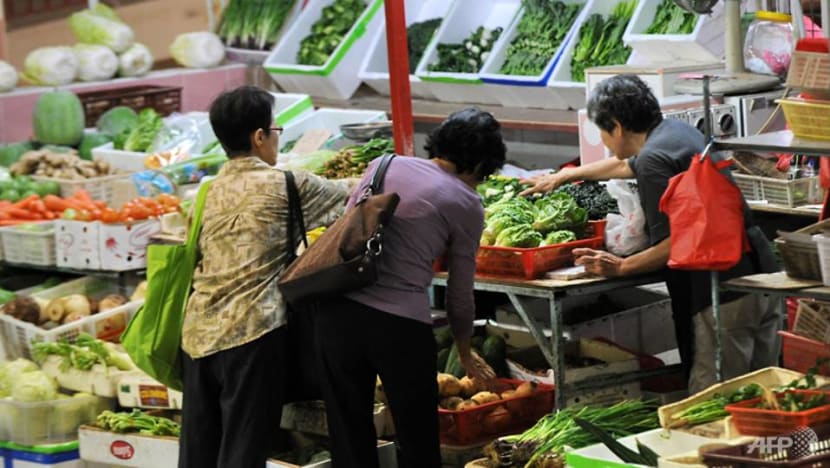Commentary: Why do so many Singapore diners dislike vegetables?
It is a shame that vegetables are sidelined in Singapore dishes, when they used to be at the heart of many Asian cuisines, says cookbook author Pamelia Chia.

BREDA, The Netherlands: From what I recall of my time living in Singapore, meat and seafood were on the table at every meal, sometimes even in every dish. While vegetables were ordered (usually just one dish to make the meal feel more virtuous), the star was always the coffee ribs, pepper crab or braised duck.
When my husband and I moved to Australia in 2019, the country was experiencing a bad spell of bushfires triggered by climate change. We felt compelled to cut down on our meat intake, and soon adjusted to eating it only several times a week.
The contrast between our average meal and the ones that we would enjoy on our trips back to Singapore was often jarring. While the meals were immensely pleasurable, the skew towards meat and seafood was so heavy, it almost felt obscene. Returning to Australia, we would find ourselves constipated from the lack of fibre and desperate for some greens.
In 2010, nine in 10 Singapore residents did not eat enough fruit and vegetables, according to the National Nutrition Survey conducted that year. That figure improved in the 2018 survey, with average vegetable consumption hitting the recommended two daily servings. But why are vegetables still overlooked in local cuisine?
VEGGIES AT THE HAWKER CENTRE
Hawker food is often thought of as everyday fare; more than half of Singaporeans eat at the hawker centre at least three times a week. However, many of these dishes are too nutritionally poor and calorically dense to be eaten on a regular basis. They are rooted in a time when many Singaporeans worked physically demanding jobs and required extra calories to perform strenuous tasks.
Even though Singaporeans now mostly work sedentary, desk-bound jobs, the face of hawker food has not changed much.
According to Shen Tan, founder of the now defunct nasi lemak stall OG Lemak, the price ceiling on hawker food might also have a part to play in the disproportionate lack of vegetables on our plates.
“Because people want to pay only S$5 and still feel like there is a lot to eat, hawkers tend to give a lot of carbohydrates to give the illusion of fullness and abundance. This has thrown the balance off a hawker dish,” she said.
Apart from some dishes such as thunder tea rice or yong tau foo, greens are glaringly absent from most hawker dishes, which comprise predominantly of carbohydrates.
Char kway teow, for example, is fried noodles with a sprinkle of beansprouts. Chicken rice comes with a few thin slices of cucumber. The few pieces of pineapple and cucumber achar are often dwarfed by the heap of chicken biryani that they accompany. These dishes may not even meet one-fifth of the daily recommended serving of vegetables.
While hawkers have been encouraged to sell healthier versions of traditional staples, this is often an uphill battle as hawker food is inextricably tied to notions of authenticity. Any deviation from the original dish could be met with resistance, as the emotions that we have attached to our favourite dishes are so potent.
On my last trip back to Singapore, I complained to my sister-in-law one night that I only had a few strands of cai xin in the hawker meals that I had eaten all day. She replied, “That is why I hardly eat at the hawker centre.”
While we might think that adhering strictly to tradition is key to protecting our hawker heritage, perhaps a better way to keep it alive is to allow the dishes to evolve with the times and needs of people.
THE SYMBOLISM OF MEAT AND SEAFOOD
I have noticed that it is not just hawker meals that are imbalanced. When my husband and I ate at restaurants with the older generation, we observed that vegetables were at times not ordered. The reasoning provided is often that the markup on vegetable dishes is the highest on a menu; it is "not worth it" to order greens at a restaurant and ordering meat or seafood dishes gives you more bang for your buck.
But, the decision to omit vegetables from a restaurant order is often far more complex. In a food-obsessed country like Singapore, food transcends nourishment; it is loaded with symbolism. Offering others meat or seafood - often the more expensive items on a menu - is a sign of generosity, hospitality and love.
Meat has also become a social marker in Singapore - a symbol of progress. Tan explained, "Not so long ago, my parents could not even afford chicken rice, so they only ate it on their payday. Or they only ate eggs on their birthday. So, for a lot of older people, big prawns or wagyu is a big deal."
EMBRACING LOCAL VEGETABLES
That said, vegetables are not popular among some of my younger friends either. When pressed, they say that the produce one gets in Singapore simply doesn't taste good.
I get where they are coming from. My first taste of pumpkin in Australia was a revelation; its dense, sweet flesh was a far cry from the water-logged specimens I had encountered in Singapore.
Yet, while produce imported from afar is undoubtedly inferior to farm-direct produce, I believe that if our attention is turned to vegetables from our region, we might find unexpected treasures.
Living overseas, I miss the crisp freshness of kang kong at Singapore wet markets, or the firm, turgid globes of gai choy that are perfect in a braise. Exploring the diversity of regional vegetables would result in meals that are fresher, more delicious and often easier on our pockets.
It is a shame that vegetables have become sidelined in our diets, when they used to be at the heart of many Asian cuisines.
Khee Shihui, founder of Tabaogirl, shared, "Many traditional foods have vegetables as their foundational elements. Abacus seeds are primarily made from yam, for example, with just a little minced meat added to flavour the entire dish. Celebrating vegetables is not just about grain bowls or raw salads."
By bringing vegetables back to our plates, we might discover that it is not just our health that flourishes, but the environment and our food culture too.
Pamelia Chia is the author of the bestselling cookbook Wet Market to Table, and the founder of Singapore Noodles, a newsletter with the mission of keeping Singapore's food heritage alive.



















